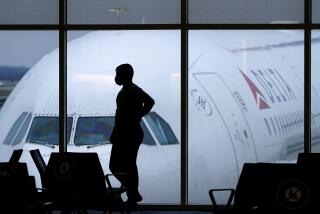118 Die as Jets Collide on Milan Runway
- Share via
MILAN, Italy — A Scandinavian Airlines System airliner taking off from Milan’s Linate airport collided Monday with a small business jet on a fog-shrouded runway, careened into a baggage hangar and burst into flames, killing all 114 people aboard the two planes and four workers on the ground.
Italian officials quickly ruled out any suspicion of a terrorist attack at the smaller of Milan’s two commercial airports, saying the country’s worst civil aviation disaster was probably the result of human error compounded by poor visibility and a defective ground radar system.
It was 8:10 a.m. when the SAS MD-87 bound for Copenhagen with 104 passengers, six crew members and a full tank of fuel was accelerating for takeoff from Linate’s only runway. The twin-engine Cessna Citation II, with two German pilots and two Italian businessmen en route to Paris, was taxiing on a perpendicular strip.
Interior Ministry spokesman Roberto Arditti said the Cessna taxied into the jetliner’s path despite standing instructions for planes to move along the perimeter of the runway instead of crossing it.
“The small plane was not where it should have been when it was hit,” he said. “The fog was very heavy and may have caused confusion.”
The SAS jet, estimated to be traveling at 200 mph, obliterated the smaller plane, then spun off the runway and into the baggage hangar, crashing against a cement beam that broke the fuselage in two, setting off a fiery explosion. The red and white building collapsed.
Charred pieces of metal landed as far as Piercarlo Papparini’s automobile repair shop, 150 yards away across a road bordering the airport.
“First I heard strange rhythmic banging, like a motor that misses,” said the 56-year-old mechanic. “I couldn’t see anything because of the fog, but I heard this banging that got closer and louder and then this explosion and a big burst of flames here at the end of this street.”
About 100 firefighters arrived quickly to contain the blaze and thick smoke but found no survivors from the planes. Four baggage handlers died in the destroyed hangar, and four others were treated at hospitals.
Fifty-six of those aboard the SAS jet were Italians. The others were not all identified; they included 16 Danes, four Finns and two foreigners living in Denmark, officials said.
Aboard the eight-seat Cessna was an Italian representative of the U.S.-based aircraft maker who was escorting an Italian packaged-food executive on a demonstration flight from Frankfurt, Germany, to Paris, with a stop in Milan.
Linate was closed for the rest of the day. Word of the disaster added to the tension in Italy following air attacks by the United States and Britain on Afghanistan. Milan’s Roman Catholic cathedral was the target of a false bomb threat Sunday night.
Salvatore Reale, a 59-year-old baggage handler who was treated for burns, told reporters at a hospital that his first thought during the fiery explosion was that a bomb in a suitcase had gone off.
But Italian Infrastructure and Transportation Minister Pietro Lunardi told a news conference that a prosecutor’s investigation had “ruled out any implication of a terrorist nature.”
The crash focused attention on the absence of an effective ground radar system not only at Linate but at most other Italian airports, which are required to have radar only to track airborne planes.
Linate has a ground radar system, but Italy’s air traffic controllers and pilots unions said it has not been functioning properly for more than a year and is scheduled to be replaced. Effective ground radar, they said, would have prevented Monday’s accident.
“Without [ground radar] and in the event of poor visibility such as today, when flight controllers couldn’t see the planes, the only method of control is ‘procedural,’ ” said Michele Bufo, chairman of the air traffic controllers union. “The pilots of all moving planes have to signal their position to the tower.”
Osvaldo Gammino, chief of the Milan branch of the Airline Operator Committee, an international aviation body that represents airlines at individual airports, said that the “iron rule” at Linate in low visibility is that all aircraft must taxi around the apron to the head of the runway but never cross it.
“It looks like the Cessna crossed the runway, which suggests an error,” he said.
SAS officials said that their flight had been cleared for takeoff and that they did not expect the Stockholm-based carrier to be blamed.
But Jorgen Lindegaard, the airline’s chief executive, said the timing of the disaster was “very inconvenient” for the airline industry, which has suffered a collapse in business since last month’s suicide hijacking attacks on the United States.
SAS offered an initial $25,000 to the next of kin of each of its passengers. The airline is 50% owned by the governments of Sweden, Norway and Denmark. The other half is publicly traded.
More to Read
Sign up for Essential California
The most important California stories and recommendations in your inbox every morning.
You may occasionally receive promotional content from the Los Angeles Times.










